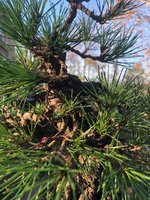Japonicus
Imperial Masterpiece
Outcompete as with landscape Japanese Maples in the landscape business whereI am not sure what you’re getting at with the “outcompetes” question.
the root stock is eternally larger than the cultivar.
Strobis and Strobiformis are much more energetic in ground on their own
As with the one I have where the graft is about 5” above the soilThe better JWP on JBP grafts will have a branch very close to the graft union. That branch is trained so that some foliage obscures the graft union from view.
another reason to have that 1st branch there so close to the union
is the fatten the trunk of the scion, blending the two, so the caliper
tapers better, rather than stepping off with a more noticeable caliper.
I never questioned using JWP grafted for bonsai.
There’s no question the better quality. It would be absurd to assume otherwise.
I emailed Brent at EGGW but probably futile. He’s discontinued JWP.
I certainly do not have the money to buy a JWP bonsai. Pre bonsai at best
but not for some time will I be able to do so hands on. Folks preach to buy several
of a type of tree and work on it to learn the species and gain experience.
I’m tryin. Plus I will have 6 cultivars of JWP to choose from to graft with if I
ever get around to that.
I will certainly need some coaching through development and refinement.
For that I have 5 cultivars. The 6th one is a 10’ landscape specimen of an
unknown cultivar that looks promising for scions.















